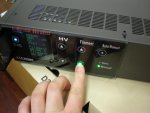alband tepmoreraly bowing in:
A combination Iknow to work (from t'internet) is circular pad size of your finger this is surrounded by a ground plane with a gap 0.5mm thick (this is crittical) the pad mus have a via going into the second layer so that you can get power to it (don't know if you have the facility to do that - I don't - hence bowing) then, a piece of pure glass 10mm thick (no clever special window stuff), this is glued onto the touch area using a glue that doesn't conduct and isn't a dialectric (can hold charge). Finding a glue like this can be tricky as most glues hold a certain amount of charge.
This is all taken from boriz's "Working link". (Don't know what went wrong with mine but thanks anyway).
alband bowing out...
oh an good luck!
 I think the pads might not be too difficult, especially if etching on PCB. But the whole thing has lots of potential problems and all a bit experimental. I might try some experimnets of my own if I get time.
I think the pads might not be too difficult, especially if etching on PCB. But the whole thing has lots of potential problems and all a bit experimental. I might try some experimnets of my own if I get time.
